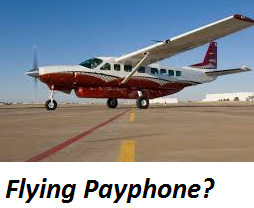International Aviation Forecast Summit Accepting 2019 Host Proposals
The Summit draws not only aviation leaders, but also global attention to the business intelligence it delivers.
Our 2018 host, Denver International Airport, has advised that the IAFS delivered $35.9 million in earned media coverage, which in turn showcased the Mile High City.
We’ve opened the process to select next year’s venue. Airports and communities interested in hosting the aviation industry’s #1 conference can get an RFP package by clicking here.
We want to once again thank Denver International Airport for making the 2018 event something very special.
Pictures are now posted… click here to view.
___________________
Connecting America To The Globe.
In Some Cases, Local Air Service Isn’t A Part of It.
We received some questions regarding the recent update that used the disappearance of pay phones as part of the same dynamics that are shifting air transportation in the US.
The point is this: the phones are gone, but the communication they once facilitated is still going on, but via different consumer channels.
 It’s the same with air access. Just because there’s no scheduled service at a given small community airport does not mean that the consumers are stuck trying to get into or out of town. As with the communication channel represented by the pay phone, they’ve switched to other modes.
It’s the same with air access. Just because there’s no scheduled service at a given small community airport does not mean that the consumers are stuck trying to get into or out of town. As with the communication channel represented by the pay phone, they’ve switched to other modes.
Often the mode is at another airport that offers better options than the population around the local airport can support. Often, these are actually more time-efficient, too, even with a long drive. Shoehorning an itinerary into the two dying flights at the local airport, and making a connection, when the distant airport has nonstop flights, makes no sense and is flatly non-competitive.
In other cases, the use of air no longer is a viable communication option. We’ve used ALB-ISP and BUF-ALB, where once robust O&D has now effectively evaporated. The process and cost of air travel is now eclipsed by other communication modes.
Studies, Analyses & Voodoo. Ignoring this reality is costing some small communities a lot of money, chasing elixirs that will get lots of passengers back at the local airport that simply cannot compete.
It is unfortunate that most of the policy thrusts coming from Washington are focused on small community airport service, which is in many cases completely at odds with consumer trends and air service economic realities.
What is also unfortunate is that frequently small communities and their airports are often guided into in blissful and expensive ignorance of what their own consumers prefer.
How ‘bout the jive-time unscientific local surveys, asking dumb questions like “would you use the local airport?” the blind positive responses from which are then assumed to be Delphi-like indications that just rolling up a plane to the gate will magically attract passengers.
Then there are the leakage analyses, replete with all sorts of expensive-to-buy ticket-purchase data and MIDT information and other voodoo, which are then passed off as proof that the local airport has great service potential. Or the “true” market studies that generally assume data to represent air service potential that’s anything but “true.”
The Consumer Is The Metric, Not Civic Hubris. And while all these rituals are going on, the consumer has found and is using other channels of communication and travel, none of which will be changed by the recruitment of one or two flights at the local airport, or worse, the emerging nonsense of just flying one market that can be operated, like, with a Cessna Caravan.
But somehow, having scheduled flights – any form, any operator, any destination –seems to be something on some small local airports’ bucket list.
Regardless of where the flights go, or whether they are connective to the global transportation system, or just ULCC service to Florida – it’s all the same. Just get scheduled flights – any scheduled flights, and the community will be saved.
Money & Studies Won’t Change Consumer Realities. Meanwhile, the consumer has usually found other channels of communication and access to air transportation. Better and often more time-efficient than whatever the local airport may be able to attract or subsidize.
 Recently, we saw a small, un-served airport, whose downtown is less than a 60 minute drive from over 600 daily nonstop flights, claim it will pony up nearly a quarter million dollars in consultant fees and incentives to get scheduled flights at the local airport.
Recently, we saw a small, un-served airport, whose downtown is less than a 60 minute drive from over 600 daily nonstop flights, claim it will pony up nearly a quarter million dollars in consultant fees and incentives to get scheduled flights at the local airport.
Any scheduled flights will do – network carrier or ULCC – which are entirely different transportation systems – it doesn’t matter.
It won’t matter to the consumer, either, who will continue to access the globe elsewhere.
Global Connectivity Is Multi Modal. If small communities and rural America are to keep up with the rest of the global economy, that means we need to pursue new communication options and channels to make sure that they are connected.
And in many cases, it will take a whole new perspective on the value and use of the local small community airport. As we move into the future, it will be logistics and distribution that offer the real opportunities.
A scheduled Cessna 208 lumbering off the gate with three passengers bound for a zero-connect destination will indeed meet the needs of some small airports’ bucket lists.
But won’t do diddly to expand the region’s global presence. Scheduled flights are not the only option.
In some cases, they aren’t an option.